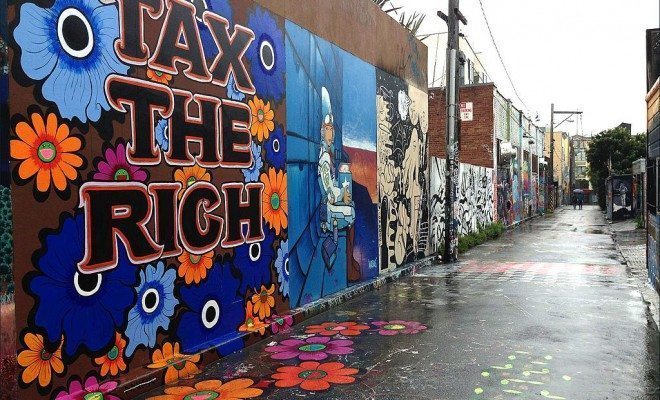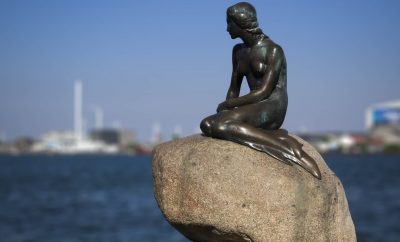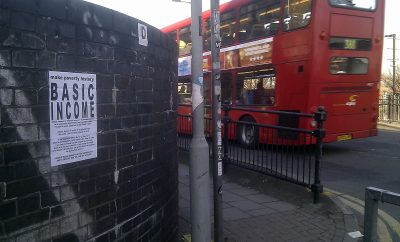
Society and Culture
Subversive San Francisco Street Art on Display at NYU’s Grey Art Gallery
Currently on view at NYU’s Grey Art Gallery, “Energy That is All Around: Mission School,” features a group of subversive San Francisco street artists from the late-1990s. Emanating from San Francisco Art Institute (SFAI), the Mission School was a direct reaction to gentrification in the Bay Area spurred by the dot-com boom that brought an influx of young professionals, upscale boutiques, restaurants, inflated rents, and threats of eviction to the primarily working-class Latino families of San Francisco’s Mission District.
“A lot of people were displaced,” said artist Chris Johnson, “everybody got fucked over.” The art of the Mission School focused on the social, political, cultural and economic aspects of everyday life in the Bay Area during this period, embodying a radical activism railing against gentrification and rampant consumerism. “They were part of a community that responded acidly to the social and aesthetic values associated with ’80s consumer culture and corporate hegemony in the dawning of the age of the internet,” said Natasha Boas, a San Francisco-based independent curator. “With their raw, immediate, and gritty street and studio practices, these post-punk, key artists of the Mission School would soon [become] international icons for new generations of art students and makers.”
The artists — Chris Johanson, Margaret Kilgallen, Alicia McCarthy, Barry McGee, Ruby Neri — share a similar aesthetic, described by McCarthy as “urban decay,” “graffiti-based,” and “Do-it-yourself.” The art is informed by lowbrow visual culture including cartoons, billboard advertisements, graffiti, and folk art. According to Lynn Gumpert, director of NYU’s Grey Art Gallery, the artworks critique society “literally standing our culture’s notion of ‘high art’ on its head.” Often employing found objects and dumpster diving for materials, their art is bound by an “anti-establishment” and “anti-capitalist” ethos, according to art critic and curator Dian Pugh whose essay ”Off The Tracks: Ethics and Aesthetics of Recent San Francisco Art” is featured in the exhibit catalogue. “Juxtaposed against the dot-com boom culture, these artists represented the moral and political voice of our cultural community — a community that was being threatened by gentrification.”
Like a modern-day John Sloan or George Bellows, Chris Johanson refers to his art as “documentary painting;” streetscapes chronicling everyday life at the dawn of the digital age. The Survivalists (1999) is a jarring installation among the pieces in the show. Flimsy wooden beams painted yellow protrude from panels on the wall, forming catwalks on which lonely consumers push shopping carts toward the viewer, perhaps conveying the alienation of labor in capitalist society. Speech bubbles from multiple figures in the panels read: “Get out of the Mission,” “Yuppies Out Now,” “Turn the building into condos,” “For Sale: Cozy One Bedroom Basement Condo, $300,000,” “Theres [sic.] no place to stay…keep on moving.” As a whole, the scene is too much to take in at once; only after reading each panel does the larger picture come into focus. “When people see this piece, they see the social anxiety,” said Chris Johanson. “I wanted to share the complexities of the socio-economic situation that everyone just had to deal with.” Voices are illustrated in a cacophonous and vexing exchange. It’s a “celebration of multiplicity,” said Dina Pugh, “that earnestly comments on existential issues of human identity comprised by consumer culture.”
Graffiti is a galvanizing force in each piece of this show. Barry McGee, also known by his tag “Twist,” presents a more cartoon-inspired aesthetic than Johansen, which is nonetheless political. “Growing up I used to see a group of activists, the Revolutionary Communist Party (RCP), who would spray-paint aggressive statements on Bank of America, government buildings, and freeway underpasses,” McGee recalled in a 2004 interview. “They shed light on atrocities being committed by the Reagan Administration’s policies in El Salvador, Nicaragua, Cuba and so on. I like that — the rawness of it.” McGee’s squat, droopy-eyed cartoon and seemingly depressed cartoon figures reflect the underside of inequitable urban change; not only the exasperated slaving masses, but also perhaps homeless, downtrodden vagabonds.
At Grey Art Gallery, the first East Coast venue to showcase the Mission School, this show is not only historically significant; it’s also relevant, according to Hi-Fructose citing “siliconvalleyization” of the Bay Area. Yet what is so striking is that the same process is currently taking place in New York City; rapid gentrification, from the city center to the periphery. Looking at the Mission District of the late-1990s, one cannot help but think of Bushwick, Brooklyn today. Both neighborhoods were inhabited by primarily working-class Latino families who, over time, have been priced out of their homes; factory buildings have been converted into artists’ lofts, and bodegas have become high-end boutiques. Public art can exacerbate the rate of gentrification, transforming working-class communities into trendy neighborhoods to which hipsters flock. But it has the potential to counter this affect as well, as Art Practical mentioned in its review of the NYU show, “there are still lessons to be learned here.”
According to Barry McGee, the landscape of contemporary public art is politically benign. “The stuff people do now doesn’t antagonize anyone at all. It has become like the mural art, which is fine in its own right but doesn’t anger people when they see it…[T]here was a time in graffiti when it was fun to do images. In hindsight, it opened the floodgates to tons of terrible art school graffiti and non-abrasive images.” McGee now advocates illicit “fundamental graffiti acts” such as tags and throw-ups, which, precisely because of their illegality, have the potential to affect social change. In such a way, the Mission School teaches us to produce graffiti as a “social practice” based on “radical pessimism” about the social environment.
The takeaway message from “Energy That is All Around: Mission School” is that art not only documents, but also has the potential it change society. And that power is open to the people.
You can see the exhibit “Energy That is All Around: Mission School” featuring artwork by Chris Johanson, Margaret Kilgallen, Alicia McCarthy, Barry McGee, and Ruby Neri at the Grey Art Gallery, New York University, 100 Washington Square East, New York, NY 10003. The exhibit is open until July 13, 2014.
—
Ryan D. Purcell (@RyanDPurcell) holds an MA in American History from Rutgers University where he explored the intersection between hip hop graffiti writers and art collectives on the Lower East Side. His research is based on experience working with the Newark Public Arts Project and from tagging independently throughout New Jersey and New York.
Featured image courtesy of [victorgrigas via wikipedia]








Comments